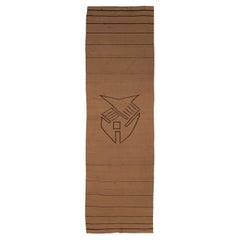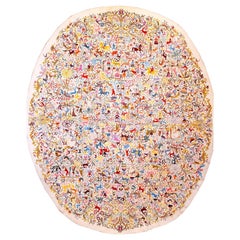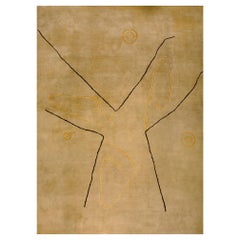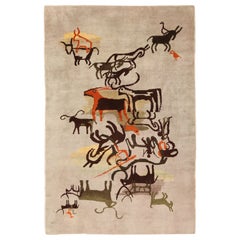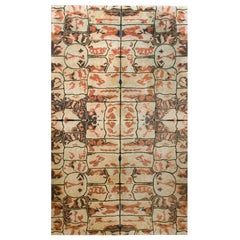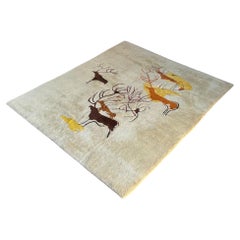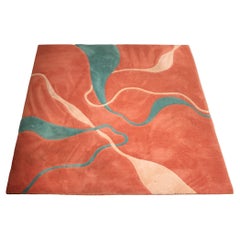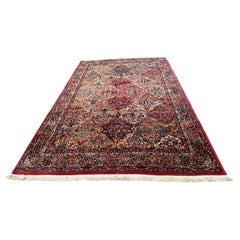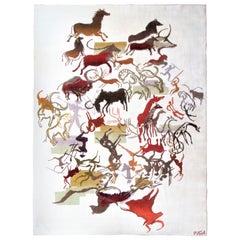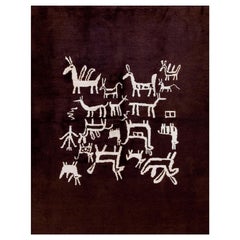Ecuadorean North and South American Rugs
to
1
Width
to
Length
to
7
2
1
1
7
6
1
1
7
7
7
7
7
7
186
1,869
1,700
303
247
3
Place of Origin: Ecuadorean
Galerie Shabab Collection Mid-20th Century Ecuadorean Textile Runner
Located in New York, NY
This mid-20th century Ecuadorean textile runner, measuring 2' 0" x 6' 8", reflects the distinct visual language of Andean weaving traditions. Set against a warm, earthy brown ground,...
Category
Mid-20th Century Tribal Ecuadorean North and South American Rugs
Materials
Wool
Mid 20th Century Ecuadorian Carpet ByOlga Fisch ( 11' x 13'4"-335 x 406 )
By Olga Fisch
Located in New York, NY
Ecuadorian carpet designed by Olga Fisch 13'4" x 11'0"
Of Hungarian origin, Olga Fisch (1901-1991) emigrated in 1933, first to Morocco and in 1939 to Ecuador, ahead of the political instability wracking Europe.
Already an artist and collector of folk art, Fisch quickly took to the local arts and crafts available
in the Quito markets. Folk and Paleolithic cave art and
established a workshop creating knotted pile carpets to her individualistic and unique designs.
The firm continues today, as does the museum of (primarily) Ecuadorian folk art. Only domestic
sheep wool is employed and the rugs are firmly symmetrically (Turkish) knotted on a cotton
foundation at a density of 60,000 knots per square meter or about 40 knots per square inch.
is a rare oval creation with the “Cabalito” pattern inspired by the folk embroidery on the “danzantes’ participants in the Corpus Christi processions from Cotopaxi, Ecuador. A number of these costumes are in the Olga Fisch Folk Art Museum in Quito. The pattern densely fills the ivory field with mobile figures, horses and vegetal motives. It is reminiscent of certain Greek Island women’s costume embroideries. Often the “Cabalito” pattern occupies an oval or lobed section on an otherwise plain rectangular carpet, but here is the pattern takes up almost all of the oval, with its energetic filigree of figures, fauna and flora.
Olga Fisch carpets are as 1950s modern as they get and our examples cry out for the right Danish or Swedish modern furniture as their perfect accompaniments. Some Italian Murano glass table objects won’t hurt either.
A Neutra or Schindler house in the Los Angeles hills is definitely the perfect context,
but any midcentury ranch...
Category
1950s Vintage Ecuadorean North and South American Rugs
Materials
Wool
Mid Century Ecuadorian Carpet By Olga Fisch ( 12' 4'' x 17' 3'' - 376 x 526 cm )
Located in New York, NY
Ecuadorian Carpet
Designed by Olga Fisch
Quito, Ecuador
Middle 20th century, c. 1960
Symmetrically knotted wool pile on a wool foundation.
The “Nazca Lines” are ancient Peruvian, but...
Category
1960s Mid-Century Modern Vintage Ecuadorean North and South American Rugs
Materials
Wool
Vintage Olga Fisch Ecuadorian Rug. Size: 6' 10" x 10' 4"
By Olga Fisch
Located in New York, NY
Stunning vintage Ecuadorian rug by Olga Fisch, origin: Ecuador, circa mid-20th century. Size: 6 ft 10 in x 10 ft 4 in (2.08 m x 3.15 m)
Olga Fisch was an inspired artist of the mid-...
Category
Mid-20th Century Art Deco Ecuadorean North and South American Rugs
Materials
Wool
Rare Vintage Ecuadorian Rug
Located in Chicago, IL
A rare mid-20th century Ecuadorian hand-knotted wool rug with a mirrored pattern of abstract reptile scale patterns, or up-close floral patterns, or distorted landscape patterns, all...
Category
Mid-20th Century Tribal Ecuadorean North and South American Rugs
Materials
Wool
Olga Fisch Modernist Ecuadorian Handwoven "CAVERNA" Rug, Ecuador, c.1955
By Olga Fisch
Located in San Juan Capistrano, CA
Olga Fisch Modernist Ecuadorian Handwoven "CAVERNA" Rug, Ecuador, c.1955
Category
20th Century Mid-Century Modern Ecuadorean North and South American Rugs
Materials
Wool
Olga Fisch Carpet "Caceria 'The Hunt'" Hungary/Ecuador, circa 1950
Located in Evanston, IL
A "Caceria" designed by the Hungarian Immigre Olga Fisch and hand woven circa 1950 in her Ecuador studio by local artisans. These colorful rugs were an integral part of the 1950s loo...
Category
Mid-20th Century Folk Art Ecuadorean North and South American Rugs
Materials
Wool
$2,580 Sale Price
70% Off
Related Items
Postmodern Rug by by Masland Carpets c 1980's
By Edward Fields
Located in New York, NY
Classic 1980's Hollywood Regency, Art Deco Revival, Post Modern style bespoke carpet, rug by noted American maker Masland. The carpet is constructed of spun nylon, it is in very goo...
Category
Late 20th Century Post-Modern Ecuadorean North and South American Rugs
Materials
Nylon
Vintage Karastan Rug - RR5155
Located in Shamokin Dam, PA
This is a vintage 5'9" x 9" Karastan rug from sometime after 2010 in good condition. 100% wool pile with no wear. The design was called "Panel Design #717" by the Karastan company. ...
Category
2010s Ecuadorean North and South American Rugs
Materials
Wool
Vintage Folk Art Ecuadorian Tapestry with Olga Fisch Style
By Olga Fisch
Located in Dallas, TX
78310 Vintage Folk Art Ecuadorian tapestry with olga Fisch style, 01'11 x 02'09
Category
Late 20th Century Folk Art Ecuadorean North and South American Rugs
Materials
Wool
Vintage American Braided Rug
Located in New York, NY
A vintage American Braided carpet from the second quarter of the 20th century. Although America (British-America) has been producing rugs since the 16th century it was never industrialized at the time. Colonial America had been importing European rugs through England. However, tariffs after the Revolutionary War concluded the importation business. The American rug industry boomed during the third quarter of the 19th century. What started off as a makeshift homemade project by women in the late 16th to early 17th century, braiding scrap clothing and fabrics to provide warmth and a feeling of protection for homes had now become popularized in American fashion, design, and trade. Vintage American Braided rugs...
Category
Mid-20th Century American Colonial Ecuadorean North and South American Rugs
Materials
Wool
Mid-20th Century Handmade American Braided Round / Circular Accent Carpet
Located in New York, NY
A vintage American Braid round/circular accent rug handmade during the mid-20th century.
Measures: 7' 1" x 7' 1".
Category
Mid-20th Century American Classical Ecuadorean North and South American Rugs
Materials
Wool, Yarn
Native American Navajo Handwoven Wool Geometric Rug Mat
By Native American Art
Located in Studio City, CA
A nicely woven wool mat/rug in a geometric pattern which the Navajo tribe is famed for. In fantastic vintage condition. Originally acquired some years ago and placed in storage for good keeping. From a large collection of Native American artifacts...
Category
20th Century Native American Ecuadorean North and South American Rugs
Materials
Wool
1970's Mexican Tessellated Fish Zapotec Carpet with Mid-Century Cubist Style
By Pablo Picasso
Located in Dallas, TX
79154 Vintage Tessellated Fish Zapotec Kilim Rug, 02'08 x 04'09. This exceptional handwoven wool vintage Tessellated Fish Zapotec rug is a masterstroke of cultural prestige, a rare c...
Category
Late 20th Century Aesthetic Movement Ecuadorean North and South American Rugs
Materials
Wool
Antique Navajo Rug Flatwoven Geometric Tree of Life Handwoven Rug Tapestry
Located in New York, NY
Navajo rug flat woven rug tapestry beige
Measures: 4' x6' (3'11" x 5'7")
119cm x 170cm
Circa 1920
"The woolen rug has a white background color on which are three stylized figures on each side of a center cornstalk. All are surrounded on three sides by a "guardian "figure - one side is the head and the body - the other side are the legs. The rug is a Navajo Yei rug...
Category
1940s Navajo Vintage Ecuadorean North and South American Rugs
Materials
Wool
$3,987
W 29.14 in L 58.27 in
Mid 20th Century American Hooked Rug ( 2' 3'' x 6' 4'' - 68 x 193 cm )
Located in New York, NY
Mid 20th Century American Hooked Rug ( 2' 3'' x 6' 4'' - 68 x 193 cm )
Category
1940s Vintage Ecuadorean North and South American Rugs
Materials
Wool
Vintage American Penny Rug
Located in New York, NY
A vintage American Penny carpet from the second quarter of the 20th century. American Penny rugs are often used as decorative coverings for beds, tables, dre...
Category
1940s American Classical Vintage Ecuadorean North and South American Rugs
Materials
Wool
Oval Mid-20th Century Handmade American Braided Room Size Carpet
Located in New York, NY
A vintage American Braided oval room size carpet handmade during the mid-20th century.
Measures: 9' 5" x 12' 3"
North American has never developed a unified handmade rug tradition, but rather it is the unassimilated confluence of several. From Mexico comes the Saltillo serape wearing blanket, and this stimulates the Navajo and Rio Grande (Colorado) weavers, first as blankets, then as rugs. The thrifty habits of rural America gave rise to the New England (and Western Canadian) hooked rug types, while the farmers of the Midwest recycled their disused garments into braided and rag rugs.
The closest to a real ongoing tradition are the Southwestern (New Mexican) Navajo rugs. By the 1860’s the native tribes were weaving wearing blankets with wool from the Spanish churro sheep. These were in stripe design, with combinations of undyed wool with cochineal reds and indigo blues. The multi-phase “Chief’s Blankets” from the 1870’s-80’s are a natural outgrowth of these. Machine spun red wool from Germantown in Pennsylvania appeared in the 1870’s with a bright red hitherto unobtainable. The weavers loved it and blankets appeared with bright reds, generally aniline, in “eye dazzler” patterns. Anglo traders established posts beginning in the 1890’s. Navajo weavings were perfect accompaniments not only for Western-themed decors, but for East Coast apartments, only they needed to be thicker and more rug like to be truly accepted. The traders brought Caucasian and Turkish village rugs to copy, borders were introduced and central medallions devised. The weavers continued to create on vertical looms, with a shared warp (dovetailing) weft structure to avoid slits. The warps were cotton string. Sizes were generally scatters, but occasionally a special order came in, hence antique room size Navajos are very rare and very pricey. Distinct village/pueblo styles developed. Among the best are: Two Grey Hills (considered the tightest, closest of all Navajo weaving), Crystal Springs and Ganado. Certain new patterns such as the “Storm pattern” with jagged lightning bolts emanating from a dark cloud developed. The Yei rug with dancing Kachina doll figures became popular. The palette has been expanded beyond the classic grey, tan, dark brown and cream natural wool combination to again include reds, blue and greens. Navajo pictorials include: American flags, trains and automobiles, domestic and local scenes and scenery. Individual artist weavers now command gallery shows and correspondingly elevated prices. There are several levels of Navajo work, and antique and vintage scatters with simple flat designs, medium weaves and tritonal palettes, and in good floor worthy condition are still available reasonably.
The Native American weaving tradition extends into Colorado with two piece scatters with sharp sawtooth medallions and striped end borders, with wool tapestry weave on cotton warps. These descend from the Saltillo blankets...
Category
Mid-20th Century American Classical Ecuadorean North and South American Rugs
Materials
Wool, Yarn
$3,900 Sale Price
20% Off
W 113 in L 147 in
Native American Navajo Handwoven Wool Rug or Mat
By Native American Art
Located in Studio City, CA
A nicely hand loomed Native American (likely Navajo) rug. Wonderfully designed with vivid colors and geometrical patterns. Would make for a nice addition to any collection or a perfe...
Category
20th Century Native American Ecuadorean North and South American Rugs
Materials
Wool
Previously Available Items
Ecuadorian "Caverna" Carpet by Olga Fisch - Room Size 12'x9'
By Olga Fisch
Located in Rochester, NY
Modernist Ecuadorian "Carverna" series hand knotted woven wool rug by Olga Fisch (Hungarian born, 1901 - 1990) inspired by the Magdalenian ice age Lascaux cave paintings discovered a...
Category
Mid-20th Century Mid-Century Modern Ecuadorean North and South American Rugs
Materials
Wool
Ecuadorian Rug
Located in New York, NY
Ecuadorian rug, measures: 6'2" x 7'6".
Category
1950s Vintage Ecuadorean North and South American Rugs
Materials
Wool
Vintage Handmade 'Caballito' Folklore Rug by Olga Fisch, Ecuador, circa 1950s
By Olga Fisch
Located in San Antonio, TX
This handmade folklore rug by Olga Fisch is in overall excellent condition. Caballito pattern. Signed. Retains original label,
circa 1950s. Ecuador.
Dim...
Category
1950s Mid-Century Modern Vintage Ecuadorean North and South American Rugs
Materials
Wool
Ecuadorian Carpets Designed by Olga Fisch 12'0" x 16'0"
By Olga Fisch
Located in New York, NY
Of Hungarian origin, Olga Fisch (1901-1991) emigrated in 1933, first to Morocco and in 1939 to Ecuador, head of the political instability wracking Europe. Already an artist and collector of Folk Art, Fisch quickly took to the local arts and crafts available in the Quito markets. Folk and Paleolithic cave art and established a workshop creating knotted pile carpets to her individualistic and unique designs. The firm continues today, as does the museum of (primarily) Ecuadorian Folk Art. Only domestic sheep wool is employed and the rugs are firmly symmetrically (Turkish) knotted on a cotton foundation at a density of 60,000 knots per square meter or about 40 knots per square inch. It takes four weavers about six weeks to complete a 9’ by 12’ carpet.
Our two carpets, both from the 1950s, are in her most popular and iconic-patterns. Number 21953 (12’ by 16)’ in the “Caverna” pattern, displays, on an ivory ground, and without borders, an agitated congeries of stick figures of hunters and prey, primarily deer, adapted from the Paleolithic cave paintings of Lascaux, discovered in 1940 and incredibly influential in mid-century art. Whereas most examples are in the 9’ by 12’ or 10’ by 13’ formats, this is certainly one of the largest renderings of the pattern. The increased size allows the larger hunters and animals free movement, and increases the impact of the individual figures. Small variants were also woven, with only a few animals, also on a beige ground.
Our other carpet, number 21802 (11.0 x 13.4) is a rare oval creation with the “Cabalito” pattern inspired by the folk embroidery on the “danzantes’ participants in the Corpus Christi processions from Cotopaxi, Ecuador. A number of these costumes are in the Olga Fisch Folk Art Museum in Quito. The pattern densely fills the ivory field with mobile figures, horses and vegetal motives. It is reminiscent of certain Greek Island women’s costume embroideries. Often the “Cabalito” pattern occupies an oval or lobed section on an otherwise plain rectangular carpet, but here is the pattern takes up almost all of the oval, with its energetic filigree of figures, fauna and flora.
Other popular Olga Fisch patterns include the “Churos” design with angular discrete spirals on a subtly tones beige ground, a study in midcentury...
Category
1950s Art Nouveau Vintage Ecuadorean North and South American Rugs
Materials
Wool
Deco Vintage Rug 'Churos' Signed by Olga Fisch
Located in New York, NY
Deco vintage rug (Churos) signed by Olga Fisch
Size: 11'0" × 13'0" (335 × 396 cm).
An Ecuadorian rug designed by Olga Fisch in the mid-20th century. Signed lower right corner. Hung...
Category
Mid-20th Century Art Deco Ecuadorean North and South American Rugs
Materials
Wool
Vintage Ecuadorian Pictorial Rug
Located in New York, NY
Rare mid-20th century one of a kind handmade Ecuadorian rug.
Category
1920s Black Forest Vintage Ecuadorean North and South American Rugs
Materials
Wool
Vintage Ecuadorian Rug
By Olga Fisch
Located in New York, NY
An Ecuadorian rug designed by Olga Fisch in the mid-20th century. Signed lower right corner. Hungarian born designer Olga Fisch linked the gap between ...
Category
Mid-20th Century Mid-Century Modern Ecuadorean North and South American Rugs
Materials
Wool
Handmade Antique Ecuadorian Art Deco Oriental Rug, 1930s
Located in Bordeaux, FR
Handmade antique Ecuadorian rug in original condition. The rug has wonderful geometric design on the light beige field. Large brown rectangles in darker and lighter brown colours con...
Category
Early 20th Century Ecuadorean North and South American Rugs
Materials
Wool
Art Deco Ecuadorian Rug by Olga Fisch
By Olga Fisch
Located in New York, NY
Olga Fisch nee Anhalzer (1901-1990) was an extraordinary artist, art dealer and cultural advocate. Born in Hungary, Olga Fisch traveled the world exploring the jungles of South Ameri...
Category
Mid-20th Century Ecuadorean North and South American Rugs
Materials
Wool
Vintage Ecuadorian Animal Carpet. Size: 3 ft 10 in x 5 ft 7 in (1.17 m x 1.7 m)
Located in New York, NY
Vintage animal carpet, Ecuador, Circa mid-20th century. Size: 3 ft 10 in x 5 ft 7 in (1.17 m x 1.7 m)
This striking and colorful vintage rug boasts a pattern rich with detail, symbolism, and fascinating tribal motifs. Woven by hand in the mountains of South America, this marvelous piece features the raucously vivid color and stunning tribal designs unique to Andean textiles...
Category
Mid-20th Century Mid-Century Modern Ecuadorean North and South American Rugs
Materials
Wool
Modernist Ecuadorian Rug by Olga Fisch from the "Caverna" Series
By Olga Fisch
Located in Buffalo, NY
Olga Fisch Rugs and Carpets - Olga Fisch nee Anhalzer (1901-1990) was an extraordinary artist, art dealer and cultural advocate. Born in Hungary, Olga Fisch traveled the world explor...
Category
Mid-20th Century Mid-Century Modern Ecuadorean North and South American Rugs
Materials
Wool
Art Deco Rug
Located in New York, NY
In the rug trade, term Art Deco or Deco (for short) applies to European and certain Chinese carpets that reflect the new movements in modern European decorative arts during the first...
Category
20th Century Art Deco Ecuadorean North and South American Rugs
Materials
Wool
Recently Viewed
View AllMore Ways To Browse
Mush Studios
African Mahogany Dining Table
African Sculptures 1970s
After Giambologna The Abduction Of A Sabine
Aino Aalto Cabinet
Alberto Giacometti Signed
Alberto Smania
Alexandrite Neodymium
Alms Box
Altar Flowers
Altar Frontal
Althorp Living
Alto Coffee Table
Alvar Aalto Fan Leg
Alvar Aalto Fan
Alvar Aalto Vase 3030
Alvin Chase Romantique
Amber Bar Set
